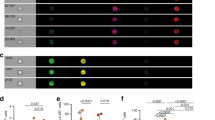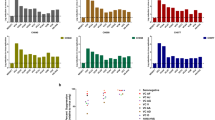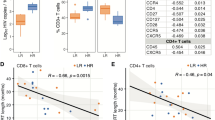Abstract
Experiments to identify cell determinants involved in HIV-1 tropism revealed a specific decrease in the expression of the T–cell activation antigen CD26 after monocytotropic (M–tropic) but not T–cell line–tropic (T–tropic) virus infection of the PM1 T–cell line. The level of CD26 expression in single–cell clones of PM1 correlated with the entry rate and cytopathicity of M–tropic HIV–1 variants, resulting in preferential survival of cells with low CD26 levels after infection. Experiments with recombinant viruses showed that the third hypervariable region of the envelope gp120 plays an important role in this selection process. This study identifies CD26 as a key marker for M–tropic human immunodeficiency virus type 1 (HIV–1) infection and suggests a mechanism for the early loss of CD26–expressing cells in HIV–1–infected individuals.
This is a preview of subscription content, access via your institution
Access options
Subscribe to this journal
Receive 12 print issues and online access
$209.00 per year
only $17.42 per issue
Buy this article
- Purchase on Springer Link
- Instant access to full article PDF
Prices may be subject to local taxes which are calculated during checkout
Similar content being viewed by others
References
Schuitemaker, H. et al. Biological phenotype of human immunodeficiency virus type-1 clones at different stages of infection: Progression of disease is associated with a shift from M-tropic to T-cell-tropic virus populations. J. Virol. 66, 1354–1360 (1992).
Koot, M. et al. HIV-1 Biological phenotype in long-term infected individuals evaluated with an MT-2 cocultivation assay. AIDS 6, 49–54 (1992).
Cheng-Mayer, C., Quiroga, M., Tung, J.W., Dina, D. & Levy, J.A. Viral determinants of human immunodeficiency virus type 1 T-cell or macrophage tropism, cytopathogenicity, and CD4 antigen modulation. J. Virol. 64, 4390–4398 (1990).
Bou-Habib, D.C. et al. Cryptic nature of envelope V3 region epitopes protects primary M-tropic human immunodeficiency virus type 1 from antibody neutralization. J. Virol. 68, 6006–6013 (1994).
Gruters, R.A. et al. Immunological and virological markers in individuals progressing from seroconversion to AIDS. AIDS 5, 837–844 (1991).
Zhu, T. et al. Genotypic and phenotypic characterization of HIV-1 patients with primary infection. Science 261, 1179–1181 (1993).
Cann, A.J. et al. The region of the envelope gene of human immunodeficiency virus type-1 responsible for determination of cell tropism. J. Virol. 66, 305–309 (1992).
Skinner, M.A. et al. Neutralizing antibodies to an immunodominant envelope sequence do not prevent gp120 binding to CD4. J. Virol. 62, 4195–4200 (1988).
de Jong, J.J., de Ronde, A., Keulen, W., Tersmette, M. & Goudsmit, J. Minimal requirements for the human immunodeficiency virus type-1 V3 domain to support the syncytium-inducing phenotype: Analysis by single arhino acid substitution. J. Virol. 66, 6777–6780 (1992).
Roderiquez, G. et al. Mediation of human immunodeficiency virus type 1 binding by interaction of cell surface heparan sulfate proteoglycans with the V3 region of envelope gp120-gp41. J. Virol 69, 2233–2239 (1995).
Maddon, P.J. et al. The T4 gene encodes the AIDS virus receptor and is expressed in the immune system and the brain. Cell 47, 333–348 (1986).
Dragic, T., Charneau, P., Clavel, F. & Alizon, M. Complementation of murine cells for human immunodeficiency virus envelope/CD4-mediated fusion in human/murine heterokaryons. J. Virol. 66, 4794–4802 (1992).
Blazquez, M.V. et al. Selective decrease of CD26 expression in T-cells from HIV-1-infected individuals. J. Immun. 149, 3073–3077 (1992).
Callebaut, C., Krust, B., Jacotot, E. & Hovanessian, A.G. T cell activation antigen, CD26, as a cofactor for entry of HIV in CD4+ cells. Science 262, 2045–2050 (1993).
Vanham, G. et al. Decreased expression of the memory marker CD26 on both CD4+ and CD8+ T lymphocytes of HIV-infected subjects. J. acquir. immun. Defic. Syndr. 6, 749–757 (1993).
Callebaut, C., Jacotot, E., Krust, B. & Havanessian, A.G. CD26 antigen and HIV fusion? [Response] Science 264, 1162–1165 (1994).
Broder, C.C. et al; Patience, C. et al; Camerini, D. et al; & Alizon, M. et al. CD26 antigen and HIV fusion? [Technical Comments] Science 264, 1156–1162 (1994).
Lazaro, I. et al. Factors involved in entry of the human immunodeficiency virus type 1 into permissive cells: Lack of evidence of a role for CD26. J. Virol 68, 6535–6546 (1994).
Morimoto, C. et al. Role of CD26/dipeptidyl peptidase IV in human immunodeficiency virus type 1 infection and apoptosis. Proc. natn. Acad. Sci. U.S.A. 91, 9960–9964 (1994).
Hildreth, J.E. & Orentas, R.J. Involvement of a leukocyte adhesion receptor (LFA-1) in HIV-induced syncytium formation. Science 244, 1075–1078 (1989).
Kido, H., Fukutomi, A. & Katunuma, N. A novel membrane-bound serine esterase in human T4+ lymphocytes immunologically reactive with antibody inhibiting syncytia induced by HIV-1. Purification and characterization. J. biol. Chem. 265, 21979–21985 (1990).
Meerloo, T., Parmentier, H.K., Osterhaus, A.D.M.E., Goudsmit, J. & Schuurman, H.J. Modulation of cell surface molecules during HIV-1 infection of H9 cells: An immunoelectron microscopic study. AIDS 6, 1105–1116 (1992).
Lusso, P. et al. Growth of macrophage-tropic and primary human immunodeficiency virus type 1 (HIV-1) isolates in a unique CD4+ T-cell clone (PM1): Failure to downregulate CD4 and to interfere with cell-line-tropic HIV-1. J. Virol 69, 3712–3720 (1995).
Ansorge, S. & Schön, E. Dipeptidyl peptidase IV in human T lymphocytes: an approach to the function of this peptidase in the immune system. Adv. Biosci. 3–10 (1987).
Bednarczyk, J.L., Carroll, S.M., Marin, C. & Mclntyre, B.W. Triggering of the proteinase dipeptidyl peptidase IV (CD26) amplifies human T lymphocyte proliferation. J. cell Biochem. 46, 206–218 (1991).
Tanaka, T. et al. Cloning and functional expression of the T cell activation antigen CD26. J. Immun. 149, 481–486 (1992).
Hoxie, J.A. et al. Alterations in T4 (CD4) protein and mRNA synthesis in cells infected with HIV. Science 234, 1123–1127 (1986).
Serpente, N. et al. Transcriptional and post-transcriptional mechanisms are involved in the absence of CD4 surface expression in two HIV-1 chronically infected T cell lines. Int. Immun. 5, 939–947 (1993).
Cann, A.J. et al. Human immunodeficiency virus type 1 T-cell tropism is determined by events prior to provirus formation. J. Virol 64, 4735–4742 (1990).
Clements, G.J. et al. The V3 loops of the HIV-1 and HIV-2 surface glycoproteins contain proteolytic cleavage sites: A possible function in viral fusion? AIDS Res. hum. Retrovir. 7, 3–16 (1991).
Torimoto, Y. et al. Coassociation of CD26 (dipeptidyl peptidase IV) with CD45 on the surface of human T lymphocytes. J. Immun. 147, 2514–2517 (1991).
Kameoka, J., Tanaka, T., Nojima, Y., Schlossman, S.F. & Morimoto, C. Direct association of adenosine deaminase with a T cell activation antigen, CD26. Science 261, 466–469 (1993).
Gutheil, W.G. et al. Human immunodeficiency virus 1 Tat binds to dipeptidyl aminopeptidase IV (CD26): A possible mechanism for Tat's immunosuppressive activity. Proc. natn. Acad. Sci. U.S.A. 91, 6594–6598 (1994).
Hafler, D.A., Fox, D.A., Benjamin, D. & Weiner, H.L. Antigen reactive memory T cells are defined by Tal. J. Immun. 137, 414–418 (1986).
Clerici, M. et al. Restoration of HIV-specific cell-mediated immune responses by interleukin-12 in vitro. Science 262, 1721–1724 (1993).
Ratner, L. et al. Complete nucleotide sequence of the AIDS virus, HTLV-III. Nature 313, 277–284 (1985).
Gartner, S. et al. The role of mononuclear phagocytes in HTLV-III/LAV infection. Science 233, 215–219 (1986).
Gallo, R.C. et al. Frequent detection and isolation of cytopathic retroviruses (HTLV-III) from patients with AIDS and at risk for AIDS. Science 224, 500–503 (1984).
Koyanagi, Y. et al. Dual infection of the central nervous system by AIDS viruses with distinct cellular tropisms. Science 236, 819–822 (1987).
Patel, M. et al. Cell-surface heparan sulfate proteoglycan mediates HIV-1 infection of T-cell lines. AIDS Res. hum. Retrovir. 9, 167–174 (1993).
Oravecz, T. & Norcross, M.A. Costimulatory properties of the human CD4 molecule: Enhancement of CD3-induced T cell activation by human immunodeficiency virus type 1 through viral envelope glycoprotein gp120. AIDS Res. hum. Retrovir. 9, 945–955 (1993).
Oravecz, T., Monostori, É., Kurucz, É., Takács, L. & Andó, I., T-cell proliferation and interleukin-2 secretion is modulated by the CD45 antigen. Scand. J. Immun. 34, 531–537 (1991).
Oravecz, T., Monostori, É., Adrian, O., Kurucz, É. & Andó, I. Novel heterogeneity of the leucocyte common antigen (CD45): Disulfide-bound heterodimers between CD45 and an 80 kDa polypeptide. Immun. Lett. 40, 7–11 (1994).
Maniatis, T., Fritsch, E.F. & Sambrook, J. Molecular Cloning: A Laboratory Manual (Cold Spring Harbor Laboratory, Cold Spring Harbor, New York, 1982).
Folks, T.M. et al. Biological and biochemical characterization of a cloned Leu-3-cell surviving infection with the acquired immune deficiency syndrome retro-virus. J. exp. Med. 164, 280–290 (1986).
Author information
Authors and Affiliations
Rights and permissions
About this article
Cite this article
Oravecz, T., Roderiquez, G., Koffi, J. et al. CD26 expression correlates with entry, replication and cytopathicity of monocytotropic HIV–1 strains in a T–cell line. Nat Med 1, 919–926 (1995). https://doi.org/10.1038/nm0995-919
Received:
Accepted:
Issue Date:
DOI: https://doi.org/10.1038/nm0995-919
This article is cited by
-
HIV-permissive cells from solid tissues: Cytokine induction and effects
Perspectives in Drug Discovery and Design (1996)
-
The role of the envelope glycoproteins in HIV-1 transmission and pathogenesis
Perspectives in Drug Discovery and Design (1996)
-
HIV and CD26
Nature Medicine (1995)



